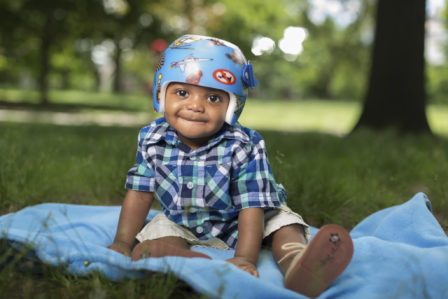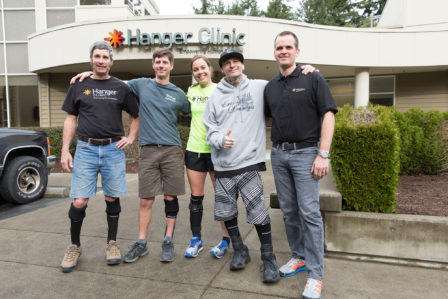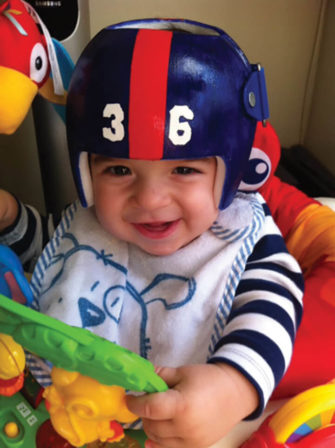Up-to-date information about Hanger Clinic’s response
Cranial Helmets
find a clinicianRecognizing that your baby has an irregular head shape can be alarming. The thought of treating him or her with a cranial remolding orthosis (CRO), also known as a cranial band or helmet, can feel even more overwhelming. We are here to help put your mind at ease by providing you with the expertise, education, and support you need to feel comfortable and confident in your decision to move forward with a cranial helmet for your little one.
Why Choose Hanger Clinic
- We have the nation’s largest network of cranial remolding specialists and have treated more CRO patients than any other provider.
- We start the CRO process later than some other providers (between 4 and 9 months old), encouraging tummy time and environmental strategies first, prior to treatment.
- Our skilled pediatric clinicians follow a set of validated, research-based Clinical Practice Guidelines, so you can rest assured your child is benefitting from the best possible clinical techniques that are backed by science.
- Our helmets are built to grow with your child, so you don’t have to go through the hassle and cost of purchasing multiple devices.
- Cranial remolding orthoses are a covered benefit under many insurance plans. We are in-network with more than 2,500 providers and provide insurance support and counseling to those who need it.
I know that going through this can be hard, but it’s so worth it. It’s such a small amount of time to make a permanent difference in your baby’s life.
Connie B., mom to Hanger Clinic patient Jake
Request a Free Evaluation
Want an expert opinion as to whether your child will benefit from a cranial helmet? Schedule a free evaluation with one of our experts at a location near you.

Cranial Asymmetry 101
Cranial asymmetry can be caused by many factors, including premature birth, congenital muscular torticollis (a tilting and/or turning of a baby’s neck to one side as a result of a muscle strain), multiple births, restrictive intrauterine positioning, trauma at birth, cervical spine abnormalities, and favoring one side over another.
There are three common asymmetrical head shapes:
- Plagiocephaly–The most common form of cranial asymmetry, plagiocephaly is usually identified by flattening on one side of the back of the head, and one eye or ear may appear higher than the other. It is sometimes referred to as a parallelogram shape, because it looks like one side of the baby’s head has been pushed forward.
- Brachycephaly–Generally appears as flattening across the back of the head with a prominent forehead, and the height of the baby’s head may appear taller.
- Scaphocephaly–Commonly seen with premature babies who spent time in a NICU or consistently rest on either side of the head, scaphocephaly is typically observed as a long, narrow head shape.
Early detection and prevention is important. One of the best ways to look for asymmetry is to look at your baby’s head from above (the bird’s eye view) while his or her hair is wet. Also look for red creases on one side of your baby’s neck as they may result from his or her head being cocked to one side.
Tummy time and repositioning are two important interventions that may help. Tummy time includes any activity where your baby’s head is not flat against a surface, encouraging head and neck control and relieving pressure. Repositioning is a focused effort to change the placement of your child’s head to reduce the risk of flat spots. For example, laying your baby’s head on the left side at bedtime tonight and on the right side tomorrow.

The Hanger Clinic Cranial Band Process
- We provide a free evaluation to help you and your pediatrician decide if and when a cranial band should be prescribed.
- If a prescription is provided, a baseline assessment is gathered using modern scanning technology, including the Insignia™ Laser Scanning System, a hand-held device used while your baby sits on your lap, or the STARscanner system, a scanning bed on which your baby lays flat for several seconds. During this appointment, you will also get to choose the color and design of your baby’s helmet.
- We will modify the scan to create a more symmetrical shape (what we want your baby’s head shape to look like) and to allow room for growth. Then, we will send the design to our central fabrication lab where the cranial band will be carefully made in a multi-step process according to FDA guidelines.
- Within 3-8 working days, your child will receive his or her helmet based on the digital scan. Your orthotist will help your baby try it on, make any necessary adjustments, and will review the wearing schedule, cleaning instructions, and follow-up appointment schedule.
- Your orthotist will give you a schedule that gradually increases the number of hours per day your child should wear the cranial band, building up to 23 hours per day after a week.
- Your follow-up appointments include mid- and full-term scans, so you can see the progress in an easy-to-read report that can be shared with your other healthcare providers and family.
Hanger Clinic Cranial Band Wear & Care
Your orthotist will create a follow up schedule to make sure your baby’s development is on track and that any adjustments are made. It is very important to follow this schedule for successful treatment.
How does the Hanger Cranial Band work?
Since 85 percent of head development occurs in the first year of life, early orthotic intervention can successfully round out the shape of your baby’s head by making the most of what he or she is doing best: growing! The cranial band gently prevents excessive growth in the direction that is most prominent, while leaving open spaces for the flattened areas of the baby’s head to grow, forming a rounder, more even shape. The optimal age for correcting plagiocephaly is between 4 and 9 months. Treatment can take place in children up to 18 months, but the level of successful correction may be compromised.
Will the orthosis be uncomfortable for my baby?
Many parents are concerned that the cranial band will be uncomfortable and their baby will have a difficult time adjusting. However, babies adapt quickly and usually don’t mind it at all. The Hanger Clinic Cranial Band is not meant to fit too tightly or to put excessive pressure anywhere on your child’s head. It is designed to be comfortable and secure. Areas where growth is being limited may become blanched or reddened, but as long as any redness fades within 20 minutes of taking off the cranial band, there is no reason to worry.
Will cranial band treatment disrupt our lifestyle?
During the first week, your baby will gradually increase the amount of time in the band to become familiar with it. He or she may show signs of displeasure at first, but your baby will grow accustomed to wearing the device. It is important to stick with the schedule we provide, even if your baby resists in the beginning.
Your family will be able to enjoy all of your favorite activities and pastimes during treatment. The band will become a normal part of your lives, and your baby will eat, sleep, snuggle and play without any issues.
Will my baby sleep OK in the cranial band?
If your child has trouble sleeping, take the cranial band off and check his or her head to make sure there are no areas of redness; if not, keep the band on. Keep in mind that there may be other things going on with your baby at the same time he or she is adjusting to the band, such as teething.
Will my baby be just as happy wearing the orthosis?
Absolutely! Wearing the cranial band will not affect your child’s personality. You’ll have the same happy baby you have today.
What about perspiration caused by the orthosis?
Expect your baby’s head to sweat a good deal during the first few weeks. With that in mind, take special care to clean the band daily, even more than once a day if needed. Excessive sweating should taper off by the end of the second or third week.
How long will my baby have to wear the Hanger Cranial Band?
After the first week, your baby will be wearing the band 23 hours per day. The length of the treatment depends on a number of factors including the amount of correction needed and the age of your baby at the start of treatment. Generally, you can expect treatment to last 3-6 months.
Will it really make a difference if I give my baby a few extra breaks from the orthosis every day?
We know how difficult it can be to have your baby in a cranial band for 23 hours a day, and we understand wanting to give your baby extra breaks from wearing the device. However, successful treatment requires a full 23 hours of wear each day. Removing it for more than one hour daily will actually prolong the treatment process and reduce the likelihood of a positive change. We know it can be challenging, but commit to the outlined schedule, and you will see results.



